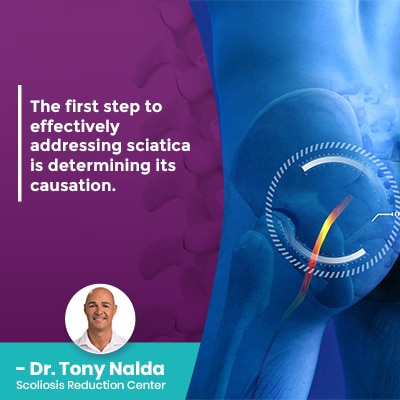What Will The Hospital Do For Sciatica Pain? Anything?

Sciatica nerve pain can range from mild and intermittent to chronic sciatica pain that's debilitating. While some cases of mild sciatic nerve pain will resolve on their own, those caused by an underlying condition require treatment addressing its underlying cause for long-term sustainable results.
Many hospital visits for sciatica land patients in the emergency room requiring pain relief from an intense condition flare-up; however, these visits are more about symptom management, and not proactive treatment. Most often, prescription medication is the typical response of ER departments.
Let's start by defining what sciatica actually means, and then explore a typical hospital response to sciatic nerve pain.
Table of Contents
What is Sciatica?
Contrary to popular opinion, sciatica isn't a condition itself, but more so refers to a set of symptoms caused by an underlying condition.
Sciatica is experiencing pain and discomfort anywhere along the path of the sciatic nerve, which is extensive; the sciatic nerve is the longest/largest nerve in the human body and originates in the lumbar spine (lower back) and extends down the buttock, thigh, leg, and into the foot.
 Typically, sciatic nerve pain is felt on one side of the body, most often the left, but it is possible that both sides of the body are affected.
Typically, sciatic nerve pain is felt on one side of the body, most often the left, but it is possible that both sides of the body are affected.
The sciatic nerve is considered a mixed nerve, as it contains both sensory and motor fibers that supply most of the thighs, legs, and feet, which is why the sciatic nerve is key to the function of the lower body.
The sciatic nerve makes movements and activities like walking, running, climbing, lifting, and standing possible.
If the sciatic nerve becomes inflamed, irritated, and/or damaged, a leg can feel stiff, be less flexible, and experience a decreased range of motion; in addition, debilitating radicular pain can be an issue, as can weakness and sensations of tingling felt anywhere along the nerve's path of the lower spine, buttocks, leg(s), and feet.
If the sciatic nerve experiences uneven forces, nerve compression and/or impingement, meaning less room for the nerves to function within, it can occur at the lumbar spine nerve root level, or anywhere along the nerve's extensive path.
Typically, the area of the body most likely to be affected is the area located closest to the affected nerve.
When a nerve root is involved, it's called lumbar radiculopathy, but is more commonly known as sciatica.
As previously mentioned, in the majority of cases, sciatica affects one side of the body, and this is determined by which leg is supplied by the compressed nerve: left or right.
It's rare that both sides of the body are affected and will depend on a number of factors.
Managing Sciatica Pain
Most people wondering how hospitals will respond to sciatica pain are referencing situations where a flare up requires immediate relief.
While hospital policy/procedure will differ depending on location and individual treatment -provider response, typically, a trip to a local emergency room is more about short-term pain relief than long-term treatment based on comprehensive assessment, diagnosis, and treatment.
In order to impact sciatica effectively, it has to be addressed as a symptom, and not a condition itself, meaning its underlying cause has to be determined so a treatment plan can be designed around it.
In most cases of a patient experiencing sciatica that's so intense they end up in the emergency room, the issues will be addressed with prescription pain relief medications and a recommendation to follow up with one's general practitioner (GP).
In some cases where magnetic resonance imaging scans are done and show inflammation, epidural lumbar steroid injections can be applied, and when guided by ultrasound, the results can be precise, but again, this is only short term relief and won't provide long-term sustainable pain management, especially when the inflammation's underlying cause hasn't been determined or addressed.
In many cases, a hospital trip for unbearable sciatic nerve pain can also involve an X-ray being done to confirm that the pain isn't caused by a recent spinal injury or underlying condition like spinal stenosis, and this is especially the case when the underlying cause of the sciatica has yet to be determined.
Now that we've explored the nature of sciatic nerve pain, let's address what can be done for sustainable long-term pain relief.
How is Sciatic Nerve Pain Treated Effectively?
 The first step to effectively addressing sciatica is determining its causation.
The first step to effectively addressing sciatica is determining its causation.
Sciatica can be caused by a number of issues/conditions, the most common of which is spinal degeneration, intervertebral disc issues, and/or the presence of underlying conditions such as spinal stenosis, cauda equina syndrome, or scoliosis.
Here at the Scoliosis Reduction Center, I would perform a comprehensive physical exam, and when appropriate, an X-ray to determine what's happening in and around the spine.
Although there are never treatment guarantees, determining its underlying cause means a treatment plan can be designed around addressing the specifics of the patient's sciatic nerve pain, including severity, experienced symptoms, and causation.
Spinal degeneration is the most common cause of sciatic nerve pain, and this is caused by natural age-related spinal deterioration, plus the cumulative effect of certain negative lifestyle choices.
Important lifestyle factors can include maintaining a healthy weight so the joints of the spine aren't strained, and activity level so the spine's surrounding muscles are kept as strong and loose as possible for optimal support, and this takes pressure off the spine and its individual structures, like its joints and discs.
In order for the spine to function as it's designed, it has to maintain its natural curves/alignment, and the spinal discs are key; as the first spinal structures to feel the effects of deterioration, disc health/function is closely tied to the development of sciatica.
Intervertebral Disc Issues and Sciatica
The vertebrae of the spine (bones) are stacked on top of one another and are separated by the spine's discs that sit between adjacent vertebrae, and if a disc changes shape or function, it can affect the vertebrae connected, disrupting the spine's natural function and stability.
Issues such as a bulging disc, disc desiccation, and/or a herniated disk can develop in the lumbar spine, and when this happens, it doesn't just impact the spinal section with the deteriorating disc, but also its surrounding nerves.
Disc degeneration/degenerative disc disease is strongly linked to desiccation, meaning excessive fluid loss that causes a change in a disc's height/shape, affecting the position of attached adjacent vertebrae.
When a disc bulges or becomes a herniated disc, this means the disc is encroaching on the space within the spinal canal, through which the sciatic nerve passes and branches out in different directions.
So if sciatic-nerve compression is caused by a structural change within the spine and/or a loss of space within the spinal canal, causing the sciatic nerve be become impinged, improvements can be made to disc health/function by addressing its underlying cause, and this can improve pain levels.
If conditions such as spinal stenosis and/or scoliosis are determined as the sciatica's underlying cause, integrating multiple condition-specific forms of treatment such as in-office physical therapy, custom-prescribed home exercises, and chiropractic care can work towards improving blood flow to affected discs, improving spinal health, function, and can help reduce sciatic nerve inflammation/compression.
Conclusion
When it comes to sciatic nerve pain, it can range from mild and intermittent to chronic sciatica pain, but to relieve sciatica pain, only proactive treatment that addresses its underlying cause can be effective long term.
Sciatic nerve pain can feel like lower back pain, radicular pain, electric shock-like sensations, tingling, and/or numbness down the buttock, leg, and into the foot.
In typical cases, sciatica pain affects the body's left side, but it can involve the right, and in rare cases, it can affect both.
The sciatic nerve is the largest and longest in the human body and is a mixed nerve containing both sensory and motor fibers that starts in the lower back (lumbar spine) and extend down the buttock, leg, and foot, and this pain can be felt at the nerve's root, or anywhere along its pathway.
Sciatic pain is caused by uneven forces exposed to the sciatic nerve, including compression and/or impingement, irritating the sciatic nerve and causing inflammation and damage; nerve damage and its symptoms are thought to be the final stage of sciatica.
Most cases of people going to the hospital for sciatic nerve pain are for excruciating pain needing immediate pain relief; while each case is unique, emergency departments at local hospitals tend to focus on symptom management, not diagnosis and treatment options.
Most often, patients are given sciatica pain treatment (muscle relaxants) to address back pain, severe pain, sudden pain, leg pain, sharp pain, abdominal pain, and a variety of sciatica symptoms.
Severe sciatica can be caused by a variety of issues/conditions including degenerative disc disease, intervertebral disc issues, natural age-related spinal degeneration, and/or the presence of an underlying spinal condition like stenosis or scoliosis.
Here at the Center, I offer patients proactive treatment for severe sciatica by working to relieve pressure on the sciatic nerve, and reduce inflammation, through a combination of physical therapy and chiropractic care to rehabilitate the entire spine, improve blood flow to affected discs, strengthen back muscles, and improving symptoms.
Dr. Tony Nalda
DOCTOR OF CHIROPRACTIC
After receiving an undergraduate degree in psychology and his Doctorate of Chiropractic from Life University, Dr. Nalda settled in Celebration, Florida and proceeded to build one of Central Florida’s most successful chiropractic clinics.
His experience with patients suffering from scoliosis, and the confusion and frustration they faced, led him to seek a specialty in scoliosis care. In 2006 he completed his Intensive Care Certification from CLEAR Institute, a leading scoliosis educational and certification center.
About Dr. Tony Nalda
 Ready to explore scoliosis treatment? Contact Us Now
Ready to explore scoliosis treatment? Contact Us Now





